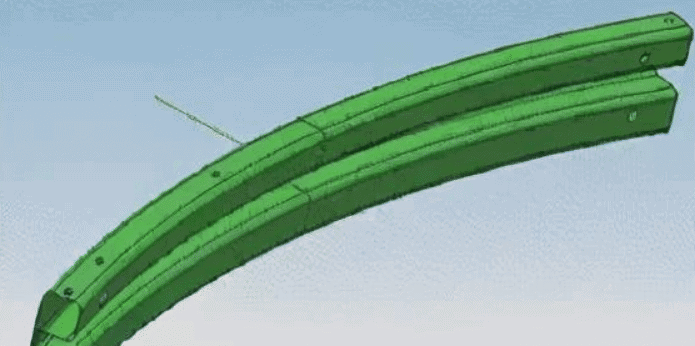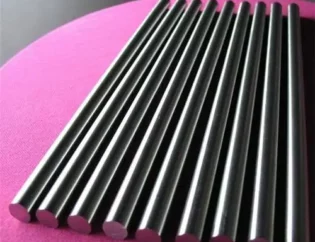Due to the poor elongation of high-strength plate, especially ultra-high-strength steel with tensile strength greater than 780MPa, it is inevitable to produce special-shaped cold-formed steel by rolling composite forming process, such as bumper body, anti-collision bar, door sill, seat rail, etc. However, different cold-formed parts with holes need to use on-line blanking, welding, automatic cutting and other equipment to combine a fully automatic rolling line, which needs to break through some key technologies. Combined with examples, this paper focuses on the key technologies of automobile bumper and anti-collision bar production equipment, and shares and exchanges with you.
1. Introduction to automatic production of automobile special-shaped rolling parts
Simultaneous interpreting the traditional cold bending steel, it is generally divided into two types: opening and closing. The door sill and guide rail are mostly open section steel, and the open bumper body is very common. Due to the limitation of the traditional stamping process, it was basically open profile in the past, and later many models still use it, such as the old Buick GL8, Jetta, Kia, Roewe 350, etc. At present, most bumper bodies are closed b-section steel, and some foreign light vehicle longitudinal beams also use closed cold-formed section steel; Most of the door anti-collision rods are round tubes, and there are also long oval and special-shaped cross-section anti-collision rods (see Figure 1).

Figure 1 crash bar
Door sill parts (see Figure 2) are basically open type, with complex end shape, and the middle and edges need to be punched or locally concave.

Figure 2 door sill
The seat guide rail (see Figure 3) is mainly made of stamping process. With the use of high-strength materials, the roll forming process can be popularized and applied.

Figure 3 seat rail
Roller bumpers are generally high-strength materials greater than 780MPa, and the profile is relatively complex, and some are even curved (see Figure 4). Most of these products have irregular holes. The accuracy requirements of individual holes are high, and the number of holes on the workpiece is different. The production line integrates punching and welding technology, which has been widely used in production. With numerical control technology, the hole position accuracy after bending can be effectively controlled. Roller medium and high frequency welding and on-line laser welding technology have also been mature and applied in China.

Figure 4 bumper
2. Introduction of high strength profile production equipment
In view of the characteristics of large output of auto parts, strict on-time production and relatively high precision requirements, its production equipment mostly adopts automatic line as the rolling part of bumper body, and its production process is from uncoiling – (leveling) – head cutting butt welding; From feeding punching (embossing) unit to roll forming, cutting and on-line welding technology, the requirements of automation and reliability are higher and higher.
The pass of high-strength (generally tensile strength less than 1200-1450mpa) cold-formed profile can be processed online or offline. However, in order to improve production efficiency, the parts that do not affect the roller design are generally locally punched before roll forming, and most of them need to be pre punched online. In the forming process of pre punched strip, there will be hole position drift, hole shape distortion, and even change the rolling deformation mechanism and springback, which will affect the product accuracy and improve the scrap rate.
2.1 rolling production line of open high-strength profile
The characteristic workpiece is the door sill and part of the bumper body. The same as the traditional roll forming process, most of them can be produced by uncoiling, roll forming and cutting units, and then do stamping processing after cutting. The difference is that the high-strength cold-formed profile forming machine must be rigid enough and have higher accuracy to reduce springback and ensure product accuracy. For the section steel that needs arc bending, complex pass and local pre convex, it must be equipped with leveling machine and on-line punching equipment. The on-line punching machine generally adopts hydraulic press and multi-mode hydraulic press, and the mechanical pressure can also be selected, but the applicable range is relatively narrow.
The bending arc of the open bumper is relatively complex. Because the springback of the high-strength steel section is difficult to control and the edge is easy to wrinkle in online bending, the rolling forming equipment is the key. Of course, it can also be completed by line pull-down bending.
2.2 automatic rolling production line of closed high-strength profile
The rolling parts of closed bumper are generally type B. most of the welded joints are in the middle of the profile. After forming, the two layers of metal need to be welded together, mainly by roll welding process. The tubular anti-collision bar is butt welded, which can be welded with high frequency or laser. For galvanized sheet, laser welding is the best, with high welding strength and small heat affected zone.
No matter what welding method is adopted, the shaping after welding shall be sufficient, and the core shall be used to increase the shaping passes when necessary. During arc bending, the die design considers the section characteristics to prevent deformation.
2.2.1 general equipment for two profile rolling lines
In order to realize automation in the production of high-strength rolled parts, the processing processes such as punching, embossing, bending, welding and deep drawing must be integrated into the production line to complete the processing of profile parts at one time. With the maturity of rolling technology and the development of optical, electrical and hydraulic control technology, the automatic production of high-strength parts has become simple.
① Uncoiler: mainly combined with the characteristics of high-strength materials with high elasticity, the functions of pressing and preventing unwinding are necessary to ensure safe production.
② Leveling machine: it is generally believed that the leveling machine is a necessary equipment for on-line punching roll line pressing, but practice has proved that the leveling machine can be omitted for the production of cold-formed parts with high-strength materials, relatively low hole position requirements and narrow profile.
③ Punching unit: the length of this type of material is generally 900-1500mm, and most of them adopt one-time punching, so it is necessary to select the equipment with large table top. In order to expand the adaptability and reduce the investment cost, the fast hydraulic press is the preferred equipment. If necessary, an embossing machine can be added to complete the identification stamping on the parts. Because the traditional roller printing process requires lettering on the roller bus, the font is easy to fall off during work. In addition, it is no longer applicable due to the high surface hardness of the material.
④ Roll forming machine: different from the traditional forming machine, it needs to adapt to the rolling of high-strength plate, so its driving performance, equipment rigidity and transmission accuracy need to be greatly improved. The quick change structure of the arch support is also often used. The semi-automatic control pneumatic jaw clutch structure can be selected to realize multi variety production. Roll accuracy and wear resistance are important factors for stable production of high-strength rolled parts.
⑤ Cutting machine: hydraulic cutting is generally adopted. For high-strength rolled parts, the cutting process will produce more heat. At the same time, due to the material yield strength of more than 1000MPa, the service life of the tool is relatively low. Therefore, knife edge design and die material selection are very important.
2.2.2 special process equipment of production line
1) On line welding equipment
It is mainly used for closed cold-formed section steel, which needs on-line welding and continuous production. It is the key point affecting the process of rolled parts, especially as automobile safety parts. At present, there are two main welding methods used in China:
① Intermittent roll welding: during intermittent roll welding, the roller rotates continuously, the workpiece moves continuously, and the current passes through the workpiece intermittently. The formed weld is composed of overlapping nuggets. Through automatic control, the welding spot spacing, welding current and on-line trimming electrode welding wheel can be set. As the current passes intermittently, the roller is designed with internal cooling and additional external cooling. In the rest time, the roller and workpiece can be cooled, so it can improve the service life of the roller, reduce the width of heat affected zone and workpiece deformation, and obtain better welding quality without the disadvantage of continuous roll welding. Of course, the disadvantage is that during intermittent roll welding, when the nugget cools, the roll plate has left the welding area, there is no sufficient forging process, and the nugget crystallizes under reduced pressure, which is easy to produce surface overheating, shrinkage cavity and crack.
At present, high frequency welding and medium frequency welding are widely used. The frequency of medium frequency welding is 1000Hz, which is faster than the welding control of 50Hz of power frequency. The current response time of medium frequency welding is 1ms, which is 20 times faster than 20ms of power frequency. The adjustment accuracy is greatly improved, so as to better ensure the welding quality.








